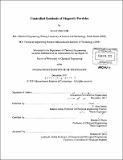Controlled synthesis of magnetic particles
Author(s)
Suh, Su Kyung, Ph. D. Massachusetts Institute of Technology
DownloadFull printable version (16.63Mb)
Other Contributors
Massachusetts Institute of Technology. Dept. of Chemical Engineering.
Advisor
T. Alan Hatton and Patrick S. Doyle.
Terms of use
Metadata
Show full item recordAbstract
Magnetic particles have been used for many applications demanding a broad range of particles morphologies and chemistries. Superparamagnetism is advantageous over ferromagnetism because it enables us to control and recover magnetic nanoparticles during and after chemical processing. Superparamagnetic particles have an oriented magnetic moment under a magnetic field but lose this behavior in the absence of a field. Ferromagnetic materials can be superparamagnetic when they consist of a single size domain, which is on the order of 10s of nanometers. However, since the magnetic force is proportional to the volume of the particle, one needs to apply higher gradient of magnetic field to recover smaller particles. Therefore, large particles are preferred for easy manipulation using external forces. For this reason, the synthesis of large, superparamagnetic particles is very important and is desirable for future applications. The purpose of this work is (1) to examine the three synthesis methods of superparamagnetic units, (2) to understand the behavior of particles created using these methods as well as the synthesis mechanisms, and (3) to investigate the potential applications of these particles. Large paramagnetic particles can be made by assembling superparamagnetic nanoparticles. We developed a method for the process-dependent clustering of monodisperse magnetic nanoparticles using a solvent evaporation method from solid-in-oilin- water (S/O/W) type emulsions. When polymers that are incompatible with the nanoparticle coatings were included in the emulsion formulation, monolayer- and multilayer-coated polymer beads and partially coated Janus beads were prepared. The precise number of nanoparticle layers depended on the polymer/magnetic nanoparticle ratio in the oil droplet phase parent emulsion. The magnetic nanoparticle superstructures responded to the application of a modest magnetic field by forming regular chains with alignment of nonuniform structures (e.g., toroids and Janus beads) in accordance with theoretical predictions and with observations in other systems. In addition, we synthesized non-spherical magnetic microparticles with multiple functionalities, shapes and chemistries. Particle synthesis is performed in two steps; polymeric microparticles homogenously functionalized with carboxyl groups were generated AA % using stop-flow lithography, and then in situ co-precipitation was used to grow magnetic nanoparticle at these carboxyl sites. With successive growth of magnetic nanoparticles, we obtained polymeric particles with saturations magnetization up to 42 emu per gram of microparticle, which is significantly greater than what can be obtained commercially. We also investigated the physical properties of magnetic nanoparticles grown in polymeric microparticles, and provide an explanation of the properties. Lastly, we used experimentation and modeling to investigate the synthesis of opaque microparticles made via stop-flow lithography. Opaque magnetic beads incorporated into hydrogel microparticles during synthesis changed the height and the degree of cross-linking of the polymer matrices formed. The effect of the concentration of the opaque material on the particle height was determined experimentally, and agreed well with model predictions based on the photopolymerization process over a wide range of UV absorbance. We also created particles with two independent anisotropies, magnetic and geometric, by applying magnetic fields during particle synthesis. Our work provides a platform for rational design of lithographic patterned opaque particles and also a new class of structured magnetic microparticles. Overall, this work demonstrates three strategies for creating magnetic substrates containing superparamagnetic nanoparticles and characterization of their resulting properties.
Description
Thesis (Ph. D.)--Massachusetts Institute of Technology, Dept. of Chemical Engineering, February 2012. Cataloged from PDF version of thesis. Includes bibliographical references.
Date issued
2012Department
Massachusetts Institute of Technology. Department of Chemical EngineeringPublisher
Massachusetts Institute of Technology
Keywords
Chemical Engineering.